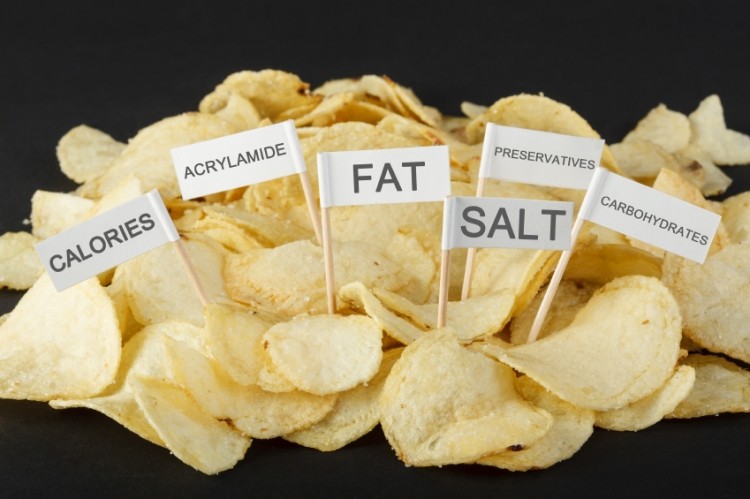'Dangerous' acrylamide levels found in one in five crisps, report reveals

Tests carried out on 92 potato snacks from major UK snack brands, such as Seabrook, along with own-brand super market crisps, revealed acrylamide levels that far exceed those currently recommended.
A sample of sweet potato crisps produced by snack brand Tyrrells revealed an acrylamide level of 2483.6 micrograms per kilogram (µg/kg), a value 2.5 times above European safety limits.
The figures are over 83-times higher than products with the lowest concentration found in Tyrrells lightly sea salted crisps and Walker’s light curly potato snacks (cheese flavour) amongst others.
The current non-binding upper recommendation within the EU for these kinds of foods is set at 1000 µg/kg with a lower benchmark given a value of 750 µg/kg.
In total, 16 samples exceeded this upper recommendation with supermarket own brand products (12 samples) performing significantly worse than major snack brands (4 samples).
The worst performing supermarket brands were Morrisons and ALDI, with three products above the benchmark each. 31 samples were above the lower EU benchmark.
“The results published today reveal that several companies found to exceed dangerous acrylamide levels by the Food Standards Agency (FSA) haven’t done anything to address this problem,” said Nusa Urbancic, campaigns director for Changing Markets, a food campaign group and authors of the report.
“Seabrook, ALDI and ASDA continue to place on the market crisps with high levels of this carcinogen. This clearly points to the failure of self-regulation by industry and weak enforcement by the FSA.”
The report’s findings closely mirror those of the FSA, who a few months ago published the results from its own tests identifying 13 products that had exceeded the recommended acrylamide benchmarks.
Products sampled from Seabrook, ALDI and ASDA brands have been found to exceed such benchmarks in both studies.
The Snack, Nut and Crisp Manufacturers’ Association (SNACMA), an industry group representing UK manufacturers of savoury snacks, responded by pointing out the study was a snapshot survey (92 samples over a one-month period in 2017).
They added that if this data was shared with the European Food Standards Authority (EFSA), it would help to inform the review of the indicative values as part of the Commission’s current proposals.
"However, this data should not be read in isolation, and should be considered alongside other data collection activities," they said.
"For example, a recent peer-reviewed study of manufacturers’ own measurements of acrylamide levels, covering a total of 40,455 samples of fresh sliced potato crisps from 20 European countries over a period of 10 years, showed a clear and significant downward trend for reduction of mean levels of acrylamide. These decreases have continued in recent years across the sector”.
Acrylamide action

Acrylamide levels in food is a topic that the food industry have been accused of sweeping under the carpet.
Along with crisps, acrylamide levels in ginger biscuits in Germany, baby biscuits in France and the UK and French fries in Belgium have all been found with high levels of acrylamide.
A lack of mandatory legal limits has made the introduction of a legislative proposal on acrylamide in food all the more urgent.
The proposals, which would legally oblige food businesses to apply Codes of Practice as a means to reduce acrylamide levels in their finished products, is currently being discussed by the European Commission and Member States and a vote is expected in June.
These Codes of Practice would also include requirements on agronomy and storage, recipe design, and process design.
They would also require businesses to regularly test products and ingredients, to trial new mitigation strategies where appropriate and to maintain records to demonstrate use of these controls.
However, food safety and consumer protection groups have criticized the action citing a failure to introduce legally binding maximum limits for acrylamide in food.
Acrylamide is already regulated at the EU level in water, plastic packaging and other sources.
The food industry had developed a code of practice for reducing acrylamide in different product groups back in 2006.
According to Changing Markets, the voluntary approach had failed to reduce the levels of acrylamide in food.
“European legislators cannot continue to turn a blind eye to the wealth of data showing that high levels of acrylamide in every day products like crisps and baby foods continue to put consumers’ health at risk” said Urbancic.
“Industrially prepared food is the biggest source of consumer exposure to this carcinogen and only immediate introduction of legally binding limits will guarantee that industry does its job and that consumers don’t have to worry about acrylamide in their food.”
In response, SNACMA said that the occurrence of acrylamide in foods was dependent upon a wide and complex range of factors which include agronomy, recipe design, and process design and control.
"As a sector we have identified and applied a series of tools which can impact upon acrylamide formation, and their use has resulted in significant reductions in detected levels within in our products. However, natural variability within raw ingredients, across seasons and across harvests, means that we will always see some variability in levels in finished products," they said.
"We continue to invest significant resources to address the issue of acrylamide and reduce variability in processes which are under our control. This includes education, participation in crop research programmes, and the introduction of new food processing procedures and technologies."
Go for Gold
Earlier this year, the FSA launched the ‘Go for Gold’ campaign to minimise exposure to acrylamide when cooking at home.
Speaking at launch in January, Steve Wearne, director of policy at the FSA said that the agency was continuing to work closely with the food industry to reduce acrylamide in food.
Initiatives already available include FoodDrinkEurope’s document known as the ‘toolkit’ that outlines ways of reducing acrylamide in food manufacture for a variety of foods and processes.
In addition The British Hospitality Association have also developed an easy-to-follow best practice guide that can be used by food business operators in the catering and food sectors.
This can help identify and implement measures to reduce acrylamide levels in food.























